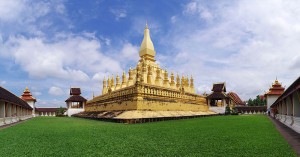Wat That Luang
Open: Daily from 08:00-12:00 and 13:00-16:00
Entrance fee: 5000 Kip per person, Laotians: 2000 Kip per person
Address:
That Luang Road
Pha That Luang is the most sacred monument in Laos as it is believed that the shrine houses a breastbone of Buddha. A local legend says that the original temple has been built around the 3rd century by an Indian missionary who brought the relict of Buddha to Laos. The current structure however was built by King Setthathirat in 1566 on the site of a 13th century Khmer temple ruin. It contains an impressive 45m high stupa.
Vientiane’s most important festival ‘Boun That Luang’ is held here in November on the night of the full moon to pay respect to the stupa and to enjoy the colourful event that includes parades, live music and religious ceremonies.
Note: there are two temples beside Pha That Luang, the one being Wat That Luang Neua to the north and Wat That Luang Tai to the south.

Wat Si Saket
Open: Daily from 08:00-12:00 and 13:00-16:00
Entrance fee: 5000 Kip per person
Address:
Intersection Lane Xang Road and Setthatthirat Road, near the Presidential Palace
Wat Si Saket is easily reachable by walking from some of Vientiane’s main attractions, such as the Patuxay or Presidential Palace. It has been built in 1818 (restored in 1935) and is considered as Vientiane’s oldest surviving Buddhist monastery and one of the few that were not destroyed by the invasion of Siamese armies in 1828, probably due to its Siamese style.

That Dam (Black Stupa)
Open: 24/7
Entrance fee: Free
Address:
Bartholomie Road, near Talat Sao (the morning market) and the US Embassy
Since Vientiane has been destroyed in 1828, it is believed that a seven headed dragon (Naga) lives here as a guardian for the citizen of the city. The stupa was once covered in pure gold, but pillaged by the Siamese during the Siamese-Lao war, leaving the stupa almost entirely black.

Wat Haw Phra Kaew
Open: Daily from 08:00 -12:00 and 13:00-16:00
Entrance fee: 5000 Kip per person
Address:
Setthathirath Road, walking distance from Wat Si Saket
Important note: Taking pictures is prohibited
It was originally built in the 16th century by King Setthathirat as temple which housed the legendary Emerald Buddha figurine, but serves now as museum. The sacred jade statue has been brought from Chiang Mai, then the capital of the kingdom of Lanna, but taken back by the Siamese in 1778 and now sits at the Wat Phra Kaew in Bangkok.
Good to know: Haw Phra Kaew derives its name from ‘Emerald Buddha’, therefore the identical names for the temple in Bangkok and then temple/now museum in Vientiane.

Wat Si Muang
www.watsimuang.com
Open: Daily 06:00 – 19:00
Entrance fee: Free; parking fees applicable
Address:
Between Setthatirat Road and Samsenthai Road
A legend says that a young pregnant woman named Si Muang sacrificed herself at this site and a pillar built over her body. There is also a small statue of Si Muang behind the building, along with a heap of old bricks that are said to date back to her time. The temple is of major focus during the Boun That Luang festival.
Tip: You can visit the monument of King Sisavang Vong next door, reachable through a gate on the grounds of Wat Si Muang.

Buddha Park or Xieng Khuan (=spirit city)
Open: Daily from 08:00 – 17:00
Entrance fee: 5000 Kip per person. 3000 Kip per camera.
Address:
24 km outside of Vientiane
East of the Friendship Bridge connecting Laos to Thailand
If you have some extra time to spare during your visit to Vientiane, take a trip to the Buddha Park. It was established in 1958 by a priest-shaman named Bunleua Sulilat and portrays over 200 Buddhist and Hindu sculptures.
